On the surface, the drop in the civilian unemployment rate to 8.6 percent signals an important and positive breakthrough. Data provided by the Federal Reserve Bank of St. Louisshows that since the most recent recession “officially” ended in June 2009, there has been an uneven, but steady downward trend in the unemployment rate.
Figure 1
Good news, right? Not necessarily. Why? The answer has to do with how we measure unemployment.
The monthly unemployment rate is based on a survey of thousands of households. Household members 16 years and over are asked questions on their employment status and whether they are actively seeking work. These results are then used to calculate the following ratio that is used to measure the unemployment rate:
People (household members) who are seeking a job but do not have one
—————————————————————————————————–
People (household members) who have a job or are actively seeking work
Notice the unemployment rate is based in part on estimating the people who are actively seeking work. This aspect of the unemployment measure can create some misleading results on the overall employment picture and how healthy an economy is.
What is called the “discouraged” or “encouraged” worker can drive the unemployment rate in a direction that is misleading about overall economic conditions. To see this, imagine the numerator in the ratio above is 8 and the number in the denominator is 100. The result is an 8 percent unemployment rate.
Consider the effect of discouraged workers. Imagine 2 people become discouraged and stop seeking work. The numerator becomes 6 and the denominator is now 98. The unemployment rate now falls from 8 percent to 6.12 percent. Even though the unemployment rate is lower this is not a good sign since the economy is not supporting opportunities for workers to seek and find employment.
Now, what about if workers become encouraged to seek employment, going from 8 to 10 people? The denominator grows to 102. The unemployment rate rises to 9.8 percent. Here the opposite occurs. New potential workers come forward because of increased optimism about employment opportunities but the result is an increase, at least temporarily, in the unemployment rate.
If we turn to the current drop in unemployment the data tell us it is driven by an increase in discouraged workers. Fully 315,000 Americans left the labor force. A true and sustained drop in unemployment will be realized once the number of discouraged workers drops, the number of encouraged workers increases and there is a net gain in total jobs that exceeds 350,000.
Figure 2 provides further perspective on how to augment unemployment data with healthy job creation. The ratio of civilian employment to the population shows a precipitous decline since 2008. We have not yet seen a sustained increase back to the levels of the mid-1980s. The good news is the drop has stopped and it appears things have stabilized.
Figure 2
A true recovery in civilian employment will occur when there are sustained drops in unemployment coupled with increases in the civilian employment-population ratio. While that process is underway, bear in mind the unemployment rate may stagnate or go up for a time as discouraged workers begin again to actively seek work.
This blog post was written by Dr. Jim Granato, Director, Hobby Center for Public Policy at the University of Houston.






Leave a Reply
You must be logged in to post a comment.